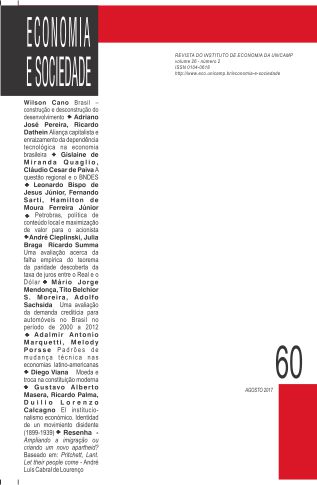Resumen
O presente artigo emprega a relação de distribuição-crescimento para descrever os padrões de progresso técnico das economias latino-americanas no período 1963-2008. A relação de distribuição-crescimento possibilita visualizar a mudança técnica ao longo do tempo. A análise revelou a predominância do padrão de progresso técnico Marx-viesado e poupador de insumos com aumento da relação capitaltrabalho no período como um todo. Também se verificou um processo de desmecanização em dois países e retrocesso do progresso técnico em outros dois países. Contudo, houve três fases na evolução do progresso técnico na América Latina, 1963-1980, 1980-2000 e 2000-2008. O padrão Marx-viesado foi predominante na primeira fase, houve regresso técnico na segunda fase, enquanto na terceira fase o padrão mais observado foi o poupador de insumos com aumento da intensidade de capital.Citas
BELLO, O.; BLYDE, J.; RESTUCCIA, D. Venezuela’s growth experience. Latin American Journal of Economics, v. 48, p. 199-226, 2011.
BONELLI, R. Produtividade e armadilha do lento crescimento. In: De NEGRI, F.; CAVALCANTE, L. (Org.). Produtividade no Brasil: desempenho e determinantes. Brasília: Ipea, 2014. p. 111-142.
COLE, H.; OHANIAN, L.; RIASCOS, R.; SCHITZ JR., J. Latin America in the Rearview Mirror. Journal of Monetary Economics, v. 52, p. 69-107, 2005.
COREMBERG, A. Fuentes del crecimiento económico en Argentina, 1990-2004. “¿Otro caso de la tiranía de los números?” Revista de Economía Política de Buenos Aires, v. 1, p. 55-88, 2011.
DUMÉNIL, G.; LÉVY, D. Capital resurgent. Roots of the neoliberal revolution. Cambridge: Harvard University Press, 2004.
ELLERY, R. Desafios para o cálculo da produtividade total dos fatores. In: DE NEGRI, F.; CAVALCANTE, L. (Org.). Produtividade no Brasil: desempenho e determinantes. Brasília: Ipea, 2014. p. 53-86.
FELIPE, J.; KUMAR, U. Technical change in India’s organized manufacturing sector. New York: Levy Economics Institute of Bard College, 2010. (Working Paper, n. 626). Disponível em: http://works.bepress.com.br/kumarutsav/21. Acesso em: 2 nov. 2011.
FELIPE, J.; McCOMBIE, J. Methodological problems with neoclassical analyses of the East Asian miracle. Cambridge Journal of Economics, v. 54, p. 695-721, 2003.
FELIPE, J.; McCOMBIE, J. Why the data tell us nothing about the importance of increasing returns to scale and externalities to capital. Economia e Sociedade, v. 17, p. 655-675, 2008.
FERREIRA, P.; PESSÔA,S.; VELOSO, F. (). On the evolution of total produtivity in Latin America. Economic Inquiry, v 51, p. 16-30, 2013.
FERRETTI, F. Patterns of technical change: a geometrical analysus using the wageprofit rate schedule. International Review of Apllied Economics, v. 22, n. 5, p. 565- 583, 2008.
FOLEY, D.; MARQUETTI, A. Economic growth from a classical perspective. In: JOANILIO, R. (Org.). Money, growth, distribution and structural change: contemporaneos analyses. Brasília: Editora UNB, 1997.
FOLEY, D.; MARQUETTI, A. Productivity, employment and growth in European Integration. Metroeconomica, v. 50, p. 277-300, 1999.
FOLEY, D.; MICHL, T. Growth and distribution. Cambridge: Harvard University Press, 1999. HARCOURT, G. (). Some Cambridge Controversesin the Theory of Capital.Cambridge: CambridgeUniversity Press. 1972
HESTON, A., SUMMERS, R.; ATEN, B. Penn World Table Version 7.0. Philadelphia: Center for International Comparisons of Production, Income and Prices at the University of Pennsylvania, 2011. Disponível em: http://pwt.econ.upenn.edu. Acesso em: 8 jan. 2012.
HOFMAN, A. The economic development of Latin America in the Twentieth Century. Northampton: Edward Elgar, 2000.
KALDOR, N. Capital accumulation and economic growth. In: LUTZ, H. (Ed.). The theory of capital. London: Palgrave, 1961. p. 177-222.
KEHOE, T.; MEZA, F. Catch-up growth followed by stagnation: Mexico, 1950- 2010. Latin American Journal of Economics, v. 48, p. 227-268, 2011.
KYDLAND, F.; ZARAZAGA, C. Argentina’s lost decade. Review of Economic Dynamics, v. 5, p. 152-165, 2002.
LOAYZA, N.; FAJNZYLBER, P.; CALDERON, C. Economic growth in Latin America and the Caribbean: stylized facts, explanations, and forecasts. Washington: World Bank, 2005.
MANUELITO, S.; JIMÉNEZ, S. Stylized features of the investment-growth connection in Latin America, 1980-2012.
CEPAL Review, v. 115, p. 7-22, 2015. MARINHO, E.; BITTENCOURT, A. Produtividade e crescimento econômico na América Latina: a abordagem da fronteira de produção estocástica. Estudos Econômicos, v. 37, n. 1, p. 5-33, 2007.
MARQUETTI, A. Analyzing historical and regional patterns of technical change from a classical-Marxian perspective. Journal of Economic Behavior & Organization, v. 52, p. 191-200, 2003.
MARQUETTI, A. Progresso técnico, distribuição e crescimento na economia brasileira: 1955-1998. Estudos Econômicos, v. 32, n. 1, p. 103-124, 2002.
MARQUETTI, A. Extended Penn World Tables, EPWT 4.0. Disponível em: http://homepage.newschool.edu/~foleyd/epwt/. Acesso em: 1 ago. 2012.
MARQUETTI, A.; OURIQUE, L.; MULLER, L. Um modelo clássico de crescimento e o padrão de catching up/falling behind na América Latina: 1969- 2003. Porto Alegre: UFRGS, 2009. (Texto para Discussão, n. 2009/06).
MARX, K. O capital. Rio de Janeiro: Bertrand Brasil S. A., 1994. Livro 1, v. 1.
PICHARDO, G. Economic growth models and growth tendencies in major Latin American countries and in the United States, 1963-2003. Investigación Económica, v. LXVI, n. 262, p. 59-87, 2007.
SHAIKH, A. Laws of production and laws of algebra: the Humbug production function. The Review of Economics and Statistics, v. 56, n. 1, p. 115-102, 1974.
SOLIMANO, A.; SOTO, R. Latin American economic growth in the late 20th century: evidence and interpretation. In: SOLIMANO, A. (Org.). Vanishing growth in Latin America. Cheltenham: Edward Elgar Publishers, 2006.
SRAFFA, P. Production of commoditiesby means of commodities: prelude to a critique of Economic Theory. Cambridge: Cambridge University Press, 1960.
TEMPLE, J. Aggregate production functions and growth economics. International Review of Applied Economics, v. 20, p. 301-317, 2006.
A Economia e Sociedade utiliza a licença do Creative Commons (CC), preservando assim, a integridade dos artigos em ambiente de acesso aberto.

